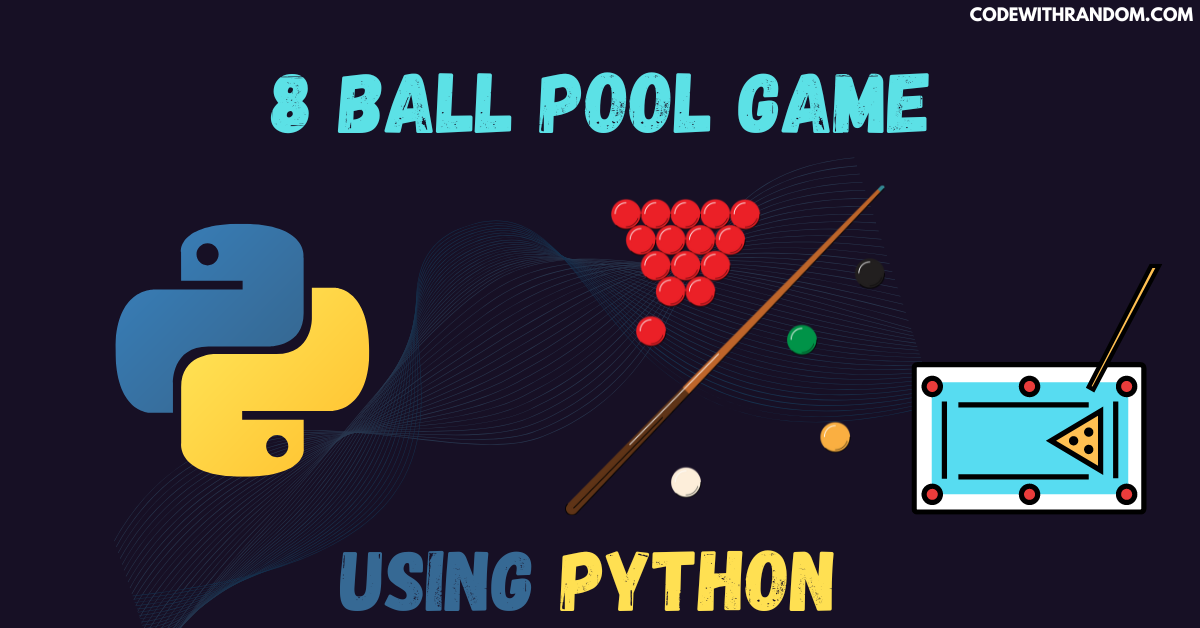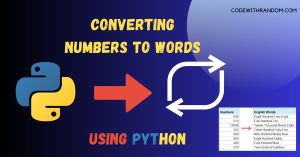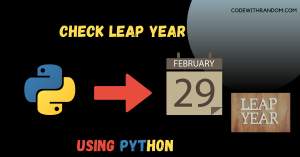How to Build 8 Ball Pool Game Using Python
Hello coder, welcome to the codewithrandom blog. It’s time to code a game in Python. In this article, we Build 8 Ball Pool Game Using Python. Creating an 8 Ball Pool Game using Python can be a challenging task, but it is possible using the Pygame library. We’ll cover the necessary steps involved in creating the game, including setting up the game window, creating the game board, adding game elements, and programming game logic.

Before Starting 8 Ball Pool Game Using Python coding, check this video to know what we are going to make:
Before we can start 8 Ball Pool Game Using Python , we need to make sure that we have Python and the pygame library installed on our computer. Here are the steps to install them:
$ pip install pygame
To play the 8 Ball Pool Game Using Python, you can follow these steps:
- open any python code Editor.
- Import the required module .
- Copy the code for the 8 Ball Pool Game Using Python, which I provided Below in this article, and save it in a file named “game.py” (or any other name you prefer).
- Run this game.py to start the game.
That’s it! Have fun playing the 8 Ball pool Game Using Python.

Here Complete Source code for the 8 Ball Pool Game Using Python project (Copy the code and Run )👇👇
import pygame
import sys
from math import *
import random
pygame.init()
width = 660
height = 360
outerHeight = 400
margin = 30
display = pygame.display.set_mode((width, outerHeight))
pygame.display.set_caption("8 Ball Pool")
clock = pygame.time.Clock()
background = (51, 51, 51)
white = (236, 240, 241)
gray = (123, 125, 125)
black = (23, 32, 42)
yellow = (244, 208, 63)
blue = (52, 152, 219)
red = (203, 67, 53)
purple = (136, 78, 160)
orange = (230, 126, 34)
green = (40, 180, 99)
brown = (100, 30, 22)
stickColor = (249, 231, 159)
colors = [yellow, blue, red, purple, orange, green, brown, black, yellow, blue, red, purple, orange, green, brown]
balls = []
noBalls = 15
radius = 10
friction = 0.005
# Ball Class
class Ball:
def __init__(self, x, y, speed, color, angle, ballNum):
self.x = x + radius
self.y = y + radius
self.color = color
self.angle = angle
self.speed = speed
self.ballNum = ballNum
self.font = pygame.font.SysFont("Agency FB", 10)
# Draws Balls on Display Window
def draw(self, x, y):
pygame.draw.ellipse(display, self.color, (x - radius, y - radius, radius*2, radius*2))
if self.color == black or self.ballNum == "cue":
ballNo = self.font.render(str(self.ballNum), True, white)
display.blit(ballNo, (x - 5, y - 5))
else:
ballNo = self.font.render(str(self.ballNum), True, black)
if self.ballNum > 9:
display.blit(ballNo, (x - 6, y - 5))
else:
display.blit(ballNo, (x - 5, y - 5))
# Moves the Ball around the Screen
def move(self):
self.speed -= friction
if self.speed <= 0:
self.speed = 0
self.x = self.x + self.speed*cos(radians(self.angle))
self.y = self.y + self.speed*sin(radians(self.angle))
if not (self.x < width - radius - margin):
self.x = width - radius - margin
self.angle = 180 - self.angle
if not(radius + margin < self.x):
self.x = radius + margin
self.angle = 180 - self.angle
if not (self.y < height - radius - margin):
self.y = height - radius - margin
self.angle = 360 - self.angle
if not(radius + margin < self.y):
self.y = radius + margin
self.angle = 360 - self.angle
# Pocket Class
class Pockets:
def __init__(self, x, y, color):
self.r = margin/2
self.x = x + self.r + 10
self.y = y + self.r + 10
self.color = color
# Draws the Pockets on Pygame Window
def draw(self):
pygame.draw.ellipse(display, self.color, (self.x - self.r, self.y - self.r, self.r*2, self.r*2))
# Checks if ball has entered the Hole
def checkPut(self):
global balls
ballsCopy = balls[:]
for i in range(len(balls)):
dist = ((self.x - balls[i].x)**2 + (self.y - balls[i].y)**2)**0.5
if dist < self.r + radius:
if balls[i] in ballsCopy:
if balls[i].ballNum == 8:
gameOver()
else:
ballsCopy.remove(balls[i])
balls = ballsCopy[:]
# Cue Stick Class
class CueStick:
def __init__(self, x, y, length, color):
self.x = x
self.y = y
self.length = length
self.color = color
self.tangent = 0
# Applies force to Cue Ball
def applyForce(self, cueBall, force):
cueBall.angle = self.tangent
cueBall.speed = force
# Draws Cue Stick on Pygame Window
def draw(self, cuex, cuey):
self.x, self.y = pygame.mouse.get_pos()
self.tangent = (degrees(atan2((cuey - self.y), (cuex - self.x))))
pygame.draw.line(display, white, (cuex + self.length*cos(radians(self.tangent)), cuey + self.length*sin(radians(self.tangent))), (cuex, cuey), 1)
pygame.draw.line(display, self.color, (self.x, self.y), (cuex, cuey), 3)
# Checks Collision
def collision(ball1, ball2):
dist = ((ball1.x - ball2.x)**2 + (ball1.y - ball2.y)**2)**0.5
if dist <= radius*2:
return True
else:
return False
# Checks if Cue Ball hits any Ball
def checkCueCollision(cueBall):
for i in range(len(balls)):
if collision(cueBall, balls[i]):
if balls[i].x == cueBall.x:
angleIncline = 2*90
else:
u1 = balls[i].speed
u2 = cueBall.speed
balls[i].speed = ((u1*cos(radians(balls[i].angle)))**2 + (u2*sin(radians(cueBall.angle)))**2)**0.5
cueBall.speed = ((u2*cos(radians(cueBall.angle)))**2 + (u1*sin(radians(balls[i].angle)))**2)**0.5
tangent = degrees((atan((balls[i].y - cueBall.y)/(balls[i].x - cueBall.x)))) + 90
angle = tangent + 90
balls[i].angle = (2*tangent - balls[i].angle)
cueBall.angle = (2*tangent - cueBall.angle)
balls[i].x += (balls[i].speed)*sin(radians(angle))
balls[i].y -= (balls[i].speed)*cos(radians(angle))
cueBall.x -= (cueBall.speed)*sin(radians(angle))
cueBall.y += (cueBall.speed)*cos(radians(angle))
# Checks Collision Between Balls
def checkCollision():
for i in range(len(balls)):
for j in range(len(balls) - 1, i, -1):
if collision(balls[i], balls[j]):
if balls[i].x == balls[j].x:
angleIncline = 2*90
else:
u1 = balls[i].speed
u2 = balls[j].speed
balls[i].speed = ((u1*cos(radians(balls[i].angle)))**2 + (u2*sin(radians(balls[j].angle)))**2)**0.5
balls[j].speed = ((u2*cos(radians(balls[j].angle)))**2 + (u1*sin(radians(balls[i].angle)))**2)**0.5
tangent = degrees((atan((balls[i].y - balls[j].y)/(balls[i].x - balls[j].x)))) + 90
angle = tangent + 90
balls[i].angle = (2*tangent - balls[i].angle)
balls[j].angle = (2*tangent - balls[j].angle)
balls[i].x += (balls[i].speed)*sin(radians(angle))
balls[i].y -= (balls[i].speed)*cos(radians(angle))
balls[j].x -= (balls[j].speed)*sin(radians(angle))
balls[j].y += (balls[j].speed)*cos(radians(angle))
def border():
pygame.draw.rect(display, gray, (0, 0, width, 30))
pygame.draw.rect(display, gray, (0, 0, 30, height))
pygame.draw.rect(display, gray, (width - 30, 0, width, height))
pygame.draw.rect(display, gray, (0, height - 30, width, height))
def score():
font = pygame.font.SysFont("Agency FB", 30)
pygame.draw.rect(display, (51, 51, 51), (0, height, width, outerHeight))
for i in range(len(balls)):
balls[i].draw((i + 1)*2*(radius + 1), height + radius + 10)
text = font.render("Remaining Balls: " + str(len(balls)), True, stickColor)
display.blit(text, (width/2 + 50, height + radius/2))
def reset():
global balls, noBalls
noBalls = 15
balls = []
s = 70
b1 = Ball(s, height/2 - 4*radius, 0, colors[0], 0, 1)
b2 = Ball(s + 2*radius, height/2 - 3*radius, 0, colors[1], 0, 2)
b3 = Ball(s, height/2 - 2*radius, 0, colors[2], 0, 3)
b4 = Ball(s + 4*radius, height/2 - 2*radius, 0, colors[3], 0, 4)
b5 = Ball(s + 2*radius, height/2 - 1*radius, 0, colors[4], 0, 5)
b6 = Ball(s, height/2, 0, colors[5], 0, 6)
b7 = Ball(s + 6*radius, height/2 - 1*radius, 0, colors[6], 0, 7)
b8 = Ball(s + 4*radius, height/2, 0, colors[7], 0, 8)
b9 = Ball(s + 8*radius, height/2, 0, colors[8], 0, 9)
b10 = Ball(s + 6*radius, height/2 + 1*radius, 0, colors[9], 0, 10)
b11 = Ball(s + 2*radius, height/2 + 1*radius, 0, colors[10], 0, 11)
b12 = Ball(s, height/2 + 2*radius, 0, colors[11], 0, 12)
b13 = Ball(s + 4*radius, height/2 + 2*radius, 0, colors[12], 0, 13)
b14 = Ball(s + 2*radius, height/2 + 3*radius, 0, colors[13], 0, 14)
b15 = Ball(s, height/2 + 4*radius, 0, colors[14], 0, 15)
balls.append(b1)
balls.append(b2)
balls.append(b3)
balls.append(b4)
balls.append(b5)
balls.append(b6)
balls.append(b7)
balls.append(b8)
balls.append(b9)
balls.append(b10)
balls.append(b11)
balls.append(b12)
balls.append(b13)
balls.append(b14)
balls.append(b15)
def gameOver():
font = pygame.font.SysFont("Agency FB", 75)
if len(balls) == 0:
text = font.render("You Won!", True, (133, 193, 233))
else:
text = font.render("You Lost! Black in Hole!", True, (241, 148, 138))
while True:
for event in pygame.event.get():
if event.type == pygame.QUIT:
close()
if event.type == pygame.KEYDOWN:
if event.key == pygame.K_q:
close()
if event.key == pygame.K_r:
poolTable()
display.blit(text, (50, height/2))
pygame.display.update()
clock.tick()
def close():
pygame.quit()
sys.exit()
# Main Function
def poolTable():
loop = True
reset()
noPockets = 6
pockets = []
p1 = Pockets(0, 0, black)
p2 = Pockets(width/2 - p1.r*2, 0, black)
p3 = Pockets(width - p1.r - margin - 5, 0, black)
p4 = Pockets(0, height - margin - 5 - p1.r, black)
p5 = Pockets(width/2 - p1.r*2, height - margin - 5 - p1.r, black)
p6 = Pockets(width - p1.r - margin - 5, height - margin - 5 - p1.r, black)
pockets.append(p1)
pockets.append(p2)
pockets.append(p3)
pockets.append(p4)
pockets.append(p5)
pockets.append(p6)
cueBall = Ball(width/2, height/2, 0, white, 0, "cue")
cueStick = CueStick(0, 0, 100, stickColor)
start = 0
end = 0
while loop:
for event in pygame.event.get():
if event.type == pygame.QUIT:
close()
if event.type == pygame.KEYDOWN:
if event.key == pygame.K_q:
close()
if event.key == pygame.K_r:
poolTable()
if event.type == pygame.MOUSEBUTTONDOWN:
start = [cueBall.x, cueBall.y]
x, y = pygame.mouse.get_pos()
end = [x ,y]
dist = ((start[0] - end[0])**2 + (start[1] - end[1])**2)**0.5
force = dist/10.0
if force > 10:
force = 10
cueStick.applyForce(cueBall, force)
display.fill(background)
cueBall.draw(cueBall.x, cueBall.y)
cueBall.move()
if not (cueBall.speed > 0):
cueStick.draw(cueBall.x, cueBall.y)
for i in range(len(balls)):
balls[i].draw(balls[i].x, balls[i].y)
for i in range(len(balls)):
balls[i].move()
checkCollision()
checkCueCollision(cueBall)
border()
for i in range(noPockets):
pockets[i].draw()
for i in range(noPockets):
pockets[i].checkPut()
if len(balls) == 1 and balls[0].ballNum == 8:
gameOver()
score()
pygame.display.update()
clock.tick(60)
poolTable()Output for the 8 ball pool game using python👇👇
Conclusion
Hurray! You have successfully Create the 8 Ball Pool Game Using Python. developing an 8 Ball Pool game using Python can be a challenging yet rewarding experience. Through this project, you can gain valuable skills in Python programming, game development, and user interface design. By using the Pygame library, you can create a user-friendly interface for your game and implement the physics and game logic of 8 Ball Pool.
Overall, developing an 8 Ball Pool game using Python is a fun and challenging project that can help you improve your programming skills while creating an engaging game for others to enjoy. Hope you enjoyed building with us! Visit our homepage and you get lot’s of projects💝.




